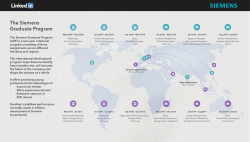
SI2 Technologies, Inc.
SI2 Technologies, Inc. Flexible, Printed Electronics for Sensing and Energy Storage iMAPS Workshop May 5, 2015 ISO-9001:2008 Certified Quality Management System Erik S. Handy, Ph.D. Principal Scientist Email: Ehandy@si2technologies.com SI2 Proprietary Phone: 978-495-5326 SI2 Technologies, Inc. 267 Boston Road N. Billerica, MA 01862 www.si2technologies.com SI2 Technologies, Inc. • SI2 Technologies, Inc. – Founded in 2003 – Small business in the metro-Boston area • Design, development and manufacture of antennas, arrays, sensors and absorbers for military air, land, sea and space applications – RF apertures and sensors focused on SWAP-C constrained platforms – Structural absorbers and honeycomb for aircraft applications – Frequency Selective Surfaces (FSS) focused on flexible and conformal printed products for radomes and sensor applications • Contract R&D directly with multiple Government agencies • Product revenues from multiple prime contractors • Management and lean technical staff with diverse technical and business backgrounds; supported by qualified vendors for specialty services and contract manufacturing SI2 provides responsive, innovative and affordable solutions 2 SI2’s Additive Manufacturing Techniques Direct Write (aka digital printing, additive manufacturing) is the ability to “write” or print electronics directly onto curved and flexible substrates from a computer file without tooling, masks, etc. • Key attributes – Digital process – Low temperature, ambient environment Micropen Dispensing for Printing onto Curved Surfaces • Enables manufacture of conformal and large area flexible electronics – Printing of electronic materials onto composites, plastics, thin films and structural materials – No etching or vacuum operations Flexible Substrate Direct Write Inkjet Printer Drying Oven • Same process from prototyping to production Printed Substrate Inkjet Roll-to-Roll System for Manufacturing on Flexible Substrates 3 SI2’s In-House Direct Write Capabilities Direct Write Inkjet • Roll to roll systems – 2 pilot systems, web widths up to 24” – 1 production system, web widths up to 44” – Additional production system ordered, install planned for 3Q14, web widths up to 44” – R&D system with multiple printers • Deposition Materials – Conductive, resistive, dielectric – Others in development (e.g. UV cure materials) • Substrate materials Direct Write Micropen Dispensing • Conformal system – R&D system – 3-axis, upgradable – ~1ft3 working envelope, larger volumes via step and repeat process • Deposition Materials – Conductive, resistive, dielectric, solder – Others in development (e.g. Magnetic materials) • Substrate materials – Composites, plastics, FR4, … – Plastics, composites, textiles, … 4 Flexible and Conformal Devices • Efficient, lightweight and small form factor • Flexible and conformal systems – Manufactured using conventional electronics and SI2’s Direct Write manufacturing technologies Ultra Lightweight Conformal Antenna Array Hybrid Wireless System Conformal Hot Film Anemometer Mortar Diagnostic Fuze 5 SI2’s Digitally Printed Electronics Roadmap Objective: Design and deliver printed electronic systems MATURE Use of hybrid (digital + conventional) manufacturing techniques can shorten time to maturity 6 Printed Coatings and Patterns • Ability to mix and grade ink types • Continue development of additional inks for specific applications Carbon - Silver nanoparticulate Inkjet films Sample 010510-A, 120 Limit 3000 2500 Average sheet resistance (OPS) Printed RF structure on 1 x 2m Kapton Carbon printed rolls of paraaramid and glass/phenolic (>10 miles printed to date) 2000 Sample 010510-A, 120 Limit 1500 1000 500 0 1.00 1.20 1.40 1.60 1.80 2.00 2.20 2.40 Conductive ink to resistive ink mix ratio (unitless) Silver to carbon mix ratio evaluation Silver - Carbon 50/50 blend on Rogers 4350 Dielectric 7 2.60 Hybrid Printed Electronics – Head Mounted Sensors Example: Blast Dosimeter integrated with military Advanced Combat Helmet – Lightweight, low-profile “hybrid” electronics (printed circuitry + conventional circuitry) – Dosimeter detects conditions which might lead to traumatic brain injury (TBI) – pressure/accelerometry – May also be applicable to protective gear for first-responders, athletes, etc. Supported by DARPA 8 Low-Cost, Hybrid Electronics Brain Recording System Accomplishments: – Developed dry, printed EEG electrodes – Demonstrated collection of EEG data – Demonstrated wireless relay of EEG data to mobile device Future Business Models: – Sale of digital printers for desktop EEG system production – Sale of printed EEG kits – Web-based “foundry” (customizable EEG kits) Supported by DARPA 9 Commercialization: Web-Based Business Model 2. SI2 downloads data, generates digital drawing 1. Customer uploads head geometry data to SI2’s website with payment 3. SI2 begins roll-to-roll manufacturing of electrodes Flexible Substrate Direct Write Inkjet Printer Drying Oven Web 6. Customer uploads EEG data to cloud Printed Substrate 4. SI2 ships completed EEG system to customer (24 hrs) 5. Customer collects EEG data using headset Use or disclosure of data contained on this sheet is subject to the restriction on title page of this document. 10 Wearable, Printed Biosensors for Human Performance Monitoring Objective: • Demonstrate analyte detection in aqueous media using printed biosensors (OFETs) Printed Biosensor Architecture Stress marker in sweat or serum binds to printed OFET Applications: Human performance monitoring Chem-bio detection Environmental monitoring Benefits of Proposed Technology: Water-stable devices Performance targets Reproducibility: <10% variance through >10,000 measurement cycles Low cost: $2-5/sensor Major Goals/Milestones: Identify most promising OFET designs for low-cost manufacturing Demonstrate in-water detection of analyte at physiological concentrations Scalable, roll-to-roll manufacturing >50,000 sensors/year Supported by the Air Force 11 Flexible Power Needs • Wearable sensors (EEG, biosensors) require low-cost, flexible power sources – Disposable power sources – Power sources that bend/flex with the wearer’s body Specific Army Challenges: • Flexible energy storage to increase the power and reduce the size/weight of armaments, unmanned systems, and individual weapons • Increased power and energy densities in devices that operate over wide temperature range and long storage periods 12 SI2’s Solution: Printed Ultracapacitors A low-cost, scalable approach to flexible ultracapacitor production Supported by U.S. Army-ARDEC 13 Printed Ultracapacitors – Status • Demonstrated flexible, lightweight ultracapacitors that met or exceeded initial Army specifications – Flexible devices will conform to curved surfaces of munitions (projectiles) or wearables (helmets) • Demonstrated use of printed ultracapacitor components as replacements for conventional components – Device printing supports low-cost manufacturing and rapid device modification • Demonstrated performance parity with comparable, non-printed ultracapacitors Concave Wall Flexible Ultracapacitor Supported by U.S. Army-ARDEC 14 Summary • SI2 developing printed components in support of size/weight/power/cost-constrained applications: – Personal health monitoring, unmanned systems – Examples: skin-contacting electrodes, sensors, energy storage devices • SI2 utilizes multiple digital manufacturing processes: – Inkjet printing (conductive inks, R2R) – Micropen dispensing (conductive pastes) – Others • SI2 has DoD-funded programs to mature these technologies • We are constantly looking for partners with complementary skills SI2 Proprietary 15 For More Information Please contact: Erik S. Handy, Ph.D. Principal Scientist SI2 Technologies, Inc. 267 Boston Road N. Billerica, MA 01862 978-495-5326 (direct) 978-495-5310 (fax) ehandy@si2technologies.com http://www.si2technologies.com 16
© Copyright 2025









